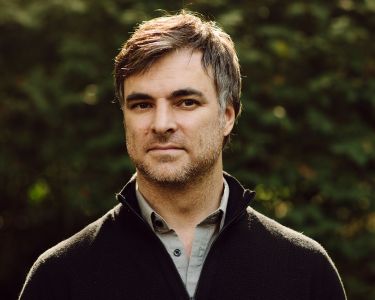
Beyond Instrumentalism
Director of Creative Industries Policy & Evidence Centre at Nesta & Fellow on Art and Society, Metcalf Foundation
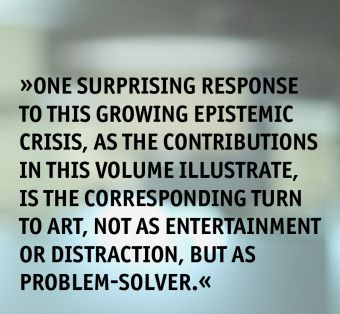
Beyond Instrumentalism: The Aestheticisation of the World
Climate change? Global pandemic? Collapsing biodiversity? Distressed migration? Spiralling inequality? Cutting across many of the urgencies facing humanity is a growing epistemic crisis, a widening gap between our knowledge paradigm and the problems of our day. One surprising response to this growing epistemic crisis, as the contributions in this volume illustrate, is the corresponding turn to art, not as entertainment or distraction, but as problem-solver. While this appears to be largely instinctive—a collective intuition ungrounded by conceptual or methodological clarity—it deserves investigation.
The Crisis of Knowing in the Age of Complexity
How did our problems and our problem-solving get so disconnected? During its rise to prominence, Western, Enlightenment rationality systematically divested itself of subjectivity in order to see the world objectively. Human values, perspectives, and beliefs were dismissed in pursuit of irrefutable facts. The complicated world has become the complex world and with a knowledge paradigm built for the former, we find ourselves, to use a recent metaphor, trying to play three-dimensional chess on a two-dimensional board. Our missing dimension often goes by the name ‘the normative’, indicating elements of identity, meaning, purpose, belief, senses of time and place, and the underlying ontologies shaping our conceptions of the world and ourselves within it. We see this in the declining capacities of our R&D paradigm, privileging science and technology and rendering contributions from the arts, humanities and social sciences illegitimate. The R&D paradigm is built for the problems of two-dimensional chess, but the crises that define our age cannot be resolved in two dimensions alone. Can knowledge creation which enriches our understanding of, and engagement with, these irreducible uncertainties, be of greater societal value in the Anthropocene?1
Art as Magic Bullet
Complexity features an entanglement of normative or human dimensions shaping the problems we are hoping to solve within a paradigm built to ignore those exact dimensions—leading much of the early 21st century on something of a fool’s errand. Yet why the turn to art? Might it weave human values, perspectives, beliefs, and activities back into how we make sense of the world, thereby allowing us to navigate—and manage—our normative entanglements more effectively? Is it, in other words, a means of shifting from the complicated to the complex by adding a third dimension to our chessboard?
From Plato’s suspicion of poets, to church and state controlling art’s expressive range, or Soviet Socialism’s faith in artists as “engineers of the human soul”, and climate activist Bill McKibben crying out “what the warming world needs now is art, sweet art,”2 the idea that art shapes worlds transcends history and ideology. These perspectives share neither politics, epistemology, nor cosmology. Where art happens, faith in its world-making power grows. We turn to art to shape our societies based on a tacit recognition of how art has shaped us, revealing both the durability and vulnerability of art’s relationship to social impact,3 from “did do for me” to “will do for others.” Herein lies the risk of instrumentalising art; often, our enthusiasm for art finds us trying to replicate effects rather than processes. In trying to replicate what art does rather than how art works we jeopardise the means by which art engages life in aesthetic terms, often disenchanting the very power for which its help was sought in the first place. These dichotomies—effects vs processes; what art does vs how art works—are not meant to dim our hopes to apply art to social challenges, but to distinguish between art as a descriptive capacity versus an epistemic capacity. If art is to expand our proverbial chessboard by shifting how we know the world beyond two-dimensional Western objectivity, it must recognise an often invisible fork in the road. Down one path, art forms a tool to serve our two-dimensional, complicated world; down the other, something potentially more transformative awaits. The latter invites the aestheticisation of the world, a reopening of that once-maligned plane of engagement we tried to close over the course of the Enlightenment.
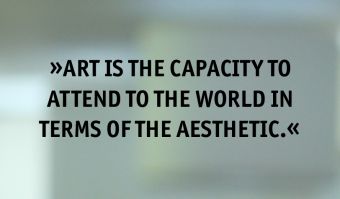
Art as Method
This growing intuition that art offers unrealised capacity to contribute to our growing epistemic crisis deserves enthusiasm. Coordinating the energy and reach of our cultural sectors while bringing them into more applied relationships to societal challenges could prove transformative. Yet such a vision implies an art-society relationship that is necessarily paradoxical—applied yet not instrumentalised, enfranchised yet not autonomous. One approach to this paradox is through a relationship between art and R&D. Historically, these fields dislike each other; art is too impulsive for R&D’s ‘systematic’ approach to knowledge creation, and R&D too reductive to admit the imaginative range of arts practices.4 Yet as art faces a destiny where it is more applied and accountable to its larger impacts, and R&D struggles with the normative dimensions of contemporary challenges, they may not be such odd bedfellows as they seem.
In terms of its value proposition, we often say art is a way of ‘seeing differently’, yet without specifying how, we jeopardise the capacity, while yielding little methodological clarity to contexts of application. Typically, art is considered a power of expression, the sounds, imagery, words, and movements it makes, often leading to its hasty use as a tool for making statements. Yet within this power of expression lies an equally important power of attention. Art is the capacity to attend to the world in terms of the aesthetic; perhaps more than its expressive power, it is perceiving via creative practice that generates such unique value. Consider this within the recursive relationship between mind and world, where mentality produces society, and society produces mentality. Such a dynamic is built for getting stuck. Agency, inspiration, reflexivity and creativity are constrained by design, and design is constrained by agency. Art as a power of attention, a means to engage the world less hampered by this recursive dynamic, offers a unique value that might make the arts vital to innovation. Rendering this explicit articulates a value proposition we can use to operationalise art in service of our worlds while protecting it from being reduced to a charismatic mouthpiece—that ‘power of expression’ alone.
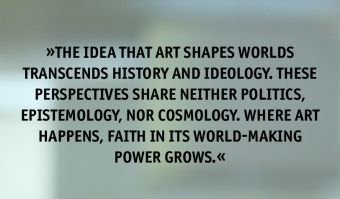
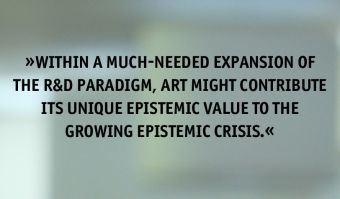
Framing problems in terms of aesthetics is essential to effective applications of arts practices. How do we spot the arts-shaped holes in our world? Here we begin to shape that third dimension on our chess board. Often, we equate the normative with matters of taste and opinion, luring us into thinking that information, data, facts and reason might inspire the reflexivity societal problems like climate change, pandemics, and social and economic justice require. As is far too abundantly evident, divisive dialogue and increasing polarisation are the results of this misconception. Fostering reflexivity, agency, and change at the normative level—that is, navigating that third dimension of our chessboard—requires fashioning carefully constructed passageways that lead from one world to another. Consider how many of us are eager to depart toxic capitalism. Bringing such hope into an applied and accountable relationship with society requires careful consideration of method and evaluation. Clearer problem statements enable more specific questions of artistic method—e.g. what processes engage the problem? And how will stakeholders be involved? In terms of evaluation, words like ‘data’ and ‘assessment’ sound threatening to artists. With clear problem statements and corresponding methods established by the artistic process, can we reconcile the accountabilities of others with our own? In other words, what value does the artistic process seek to produce? Where was this contribution realised or not? What data do we need in order to know? And what processes will be used to interpret and integrate that data in decision-making? This more empowered relationship to assessment allows applied artistic processes to serve more accountable roles in society without trying to prove themselves on foreign terms.
Policy for Playing Three-dimensional Chess
Our core suggestion is that within a much-needed expansion of the R&D paradigm, art might contribute its unique epistemic value to the growing epistemic crisis.
The starting point is to reflect the arts’ distinctive contribution to R&D in the international bible for R&D policymakers, the Organisation for Economic Cooperation and Development’s Frascati Manual: Guidelines for Collecting and Reporting Data on Research and Experimental Development. Now in its seventh edition, the Manual is used by policymakers, statisticians, academics, and others, to help standardise the data collection guidelines and classifications for compiling R&D statistics. In successive revisions, the Frascati Manual has evolved to recognise arts R&D, but it has done so by shoehorning art into scientific understandings rather than extending its own definitions and parameters, e.g., referring to “observable facts” and “knowledge of the underlying foundations of phenomena” not to behaviours, and to “systematic work… directed to producing new products or processes” not to human experiences. Elsewhere in the Manual it is made clear that R&D must aim to resolve scientific and technological uncertainty. It is of fundamental importance that the Frascati Manual and the R&D definitions within it are made fit for purpose for the complexity economy.5
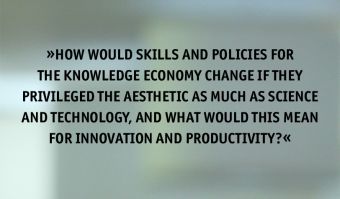
National statisticians in turn must adapt their measurement activities to measure R&D so defined.6 The basics of an approach are already in place with the OECD’s Fields of Research and Development (FORD) classification. Statisticians can use this classification in their R&D surveys to measure R&D expenditure and personnel by fields of enquiry—in other words, broad knowledge domains including the arts–based on the content of the R&D subject matter. Survey returns on R&D spending by FORD are only as good as the accounting data that organisations collect, however, so national statistical institutes need to engage with businesses, public bodies and charities to ensure they too are adapting their R&D measurement systems accordingly.
Armed with more inclusive definitions and metrics, governments can then ensure their R&D strategies, subsidies and tax incentives are fit for purpose too. They can fashion interventions that are designed to fully avail society of the R&D potential of the arts. What, for example, would the missions’ turn in innovation policy look like if artists participated in the setting of grand challenges, foresight exercises, policy design and planning? How would skills and policies for the knowledge economy change if they privileged the aesthetic as much as science and technology, and what would this mean for innovation and productivity? If the qualifying expenditures for R&D tax reliefs were widened to embrace arts R&D, while the arts learned to structure inquiry towards compelling data production, what new interdisciplinary business solutions to society’s problems might we see?
Sources
1 David Maggs, Art and the World After This. Metcalf Foundation, June, 2021.
https://metcalffoundation.com/publication/art-and-the-world-after-this/
2 Bill McKibben. “What the warming world needs now is art, sweet art,” Grist Magazine. April 2005. http://grist.org/article/mckibben-imagine/
3 David Maggs and John Robinson. Sustainability in an Imaginary World: Art and the Question of Agency. Routledge, New York, 2020. See, in particular, chapters 7 & 8.
4 Hasan Bakhshi, Alan Freeman and Radhika Desai. “Not Rocket Science: A Roadmap for Arts and Cultural R&D,” MPRA Paper 52710, University Library of Munich, Germany, revised 01 Jan 2010.
https://ideas.repec.org/p/pra/mprapa/52710.html
5 Hasan Bakhshi and Elizabeth Lomas. “Defining R&D for the Creative Industries,” Nesta/AHRC/UCL, 2017. https://ahrc.ukri.org/documents/project-reports-and-reviews/policy-briefing-digital-r-d/
6 Hasan Bakhshi, Jonathan Breckon and Ruth Puttick.”Understanding R&D in the arts, humanities and social sciences,” Journal of the British Academy, volume 9.
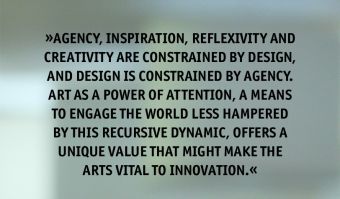
Hasan Bakhshi
Hasan is Director of the AHRC-funded Creative Industries Policy and Evidence Centre, a Nesta-led, AHRC-funded research consortium of ten universities, charged with improving the evidence base for policies to support the UK’s creative industries. Prior to Nesta, Hasan worked as Executive Director at Lehman Brothers, as Deputy Chief Economist at the Foreign and Commonwealth Office and as an economist at the Bank of England. He has published widely in academic journals and policy publications on topics ranging from technological progress and economic growth to the economics of the creative and cultural sector. He is also Adjunct Professor of Creative Industries at the Queensland University of Technology, has an honorary Doctorate from the University of Brighton for his work on economic policy for the creative industries, and in the 2015 New Year’s Honours was awarded an MBE for services to the creative industries. Hasan is a member of the government’s Creative Industries Council, the Department for Digital, Culture, Media and Sport’s Science Advisory Council and Advisory Board for its Culture and Heritage Capital Framework. In 2017, he was elected to sit on the Royal Economic Society Council.
Picture © NESTA

David Maggs
David Maggs carries on an active career as an interdisciplinary artist and researcher focused on arts, climate change, and sustainability. He is the founder and pianist for Dark by Five, has written works for the stage, and collaborated on large augmented reality and virtual reality projects (see Mummer’s Journey). David is the artistic director of the rural Canadian interarts organization Gros Morne Summer Music, and founder and co-director of the Graham Academy, a youth training academy founded in honour of his teacher and mentor, Dr. Gary Graham. He initiated and coproduced the CBC doc channel film The Country, exploring the Canadian government’s handling of indigenous identity in Newfoundland. As a fellow at the University of Toronto’s Munk School for Global Affairs, David co-authored Sustainability in an Imaginary World (Routledge Press, 2020) with mentor and longtime collaborator John Robinson. He is former senior fellow at the Institute for Advanced Studies in Sustainability in Potsdam, Germany, where he led work on culture and climate change. Currently he is the inaugural Innovation Fellow in residence at the Metcalf Foundation where he will explore the role of art in society, with particular focus on innovation, climate change, and cultural policy.
Picture © Grady Mitchell
